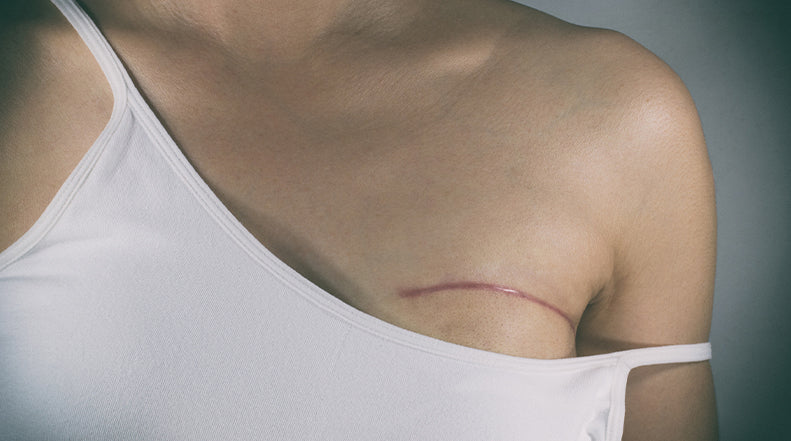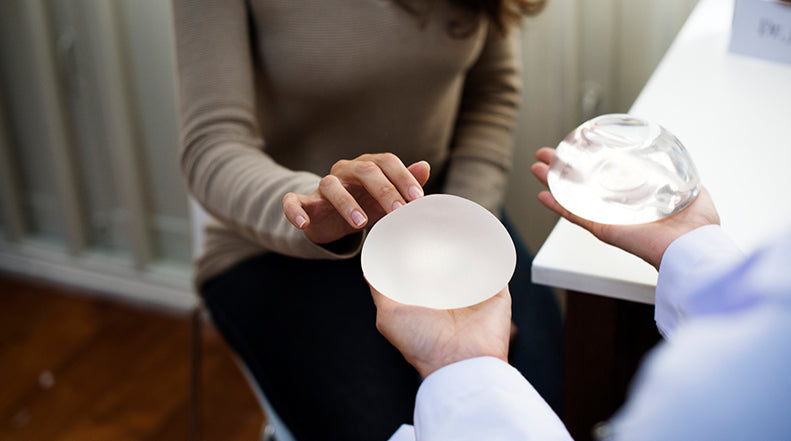What You Can Do About Breast Reconstruction Scarring

In our previous post, we discussed the differences between the various breast reconstruction options following surgeries such as mastectomies and lumpectomies. There are two main categories for breast reconstruction, one being implant-based reconstruction and the other flap reconstruction. Unfortunately, these procedures can result in significant scarring, which can lower a woman’s self-confidence and make it even more difficult for her to feel comfortable with her new breasts. Therefore, we want to share with you the top recommendation for what you can do about scarring after breast reconstruction.
WHY DOES SCAR TISSUE FORM?
As with any surgical incision, scarring after breast reconstruction occurs as a result of the body’s natural wound healing process. However, the types of scars that form depend on several factors, including which type of reconstruction is performed, the patient’s personal characteristics, and how well the wound is taken care of post-surgery.
During implant-based reconstruction, silicone or saline inserts known as breast implants are used to help form a new breast mound. Using an implant to rebuild the breast requires less surgery than flap reconstruction, since it only involves the chest area (and not a tissue donor site). However, it also may require additional surgery in the future, as implants can wear out and develop other issues, such as tightness of scar tissue around the implant. According to the American Society for Aesthetic Plastic Surgery, both saline and silicone implants should last between 10 and 20 years. Thus, while implant-based breast reconstruction will result in less scarring initially, the potential for scarring in the future due to additional surgeries should be considered.
Flap (or autologous) reconstruction uses the patient's own tissue (skin, fat, and sometimes muscle) from another part of the body to form a new breast. The tissue (called a "flap") usually comes from the belly, the back, buttocks, or inner thighs to create the reconstructed breast. There are two ways in which the flap can be obtained. In one method, the tissue is completely separated from its original blood vessels and picked up and moved to its new place in the chest. This is frequently referred to as a “free flap.” Another method is to keep the tissue attached to its original blood vessels and move it under the skin to the chest. This is often referred to as a “pedicled flap.” In both types, the tissue is formed into the shape of a breast and stitched into place.
After the incision is closed, the body begins the wound healing process. The area will become red and inflamed as blood vessels dilate to allow more oxygen, nutrients, and immune mediators to the site in order to begin healing the wound. The next step in the wound healing process is proliferation, which means the cells around the wound begin to multiply rapidly. The new cells grow from the outer edges of the wound toward the center, and unite in order to form the new layer of skin. The final stage of wound healing is tissue remodeling, a complex process that can last anywhere from several months to years. In this stage, fibroblasts (a type of connective tissue cell) are signaled to produce collagen to support the newly formed tissue. Then, the collagen fibers are organized and cross-linked along tension lines (the natural orientation of collagen fibers in the dermis). You may also hear this process referred to as the scar maturation process.
Unfortunately, incisions in the chest area and breast tissue have a greater propensity for scarring when compared to other areas of the body. This is because there is always tension in these areas of the chest, which causes scars to widen and thicken.
HOW NEWGEL+ PRODUCTS CAN HELP
Now that you understand why scarring after breast reconstruction occurs, we want to share with you the treatment that is recommended by scar management experts as the first line therapy for the prevention and treatment of scars: silicone gel.
Silicone gel exerts several actions that help wounds to heal well and also to minimize the appearance of scars. The adhesive silicone gel products improve scars by providing a combination of occlusion (seals the scar from exposure to air), hydration, elevated skin temperature and continuous light pressure. Alternatively, when topical silicone gel is applied to a scar it spreads as an ultra thin sheet and dries within 4 to 5 minutes due to its self-drying technology, which improves scars by providing a combination of occlusion (seals the scar from exposure to air) and hydration.
All of the NewGel+ scar treatment products have been formulated with medical grade silicones to soften, flatten, and fade your scar. NewGel+ even has products specially designed to meet the needs of any breast surgery, such as areola circles, lollypops, and anchors. Don’t forget to treat the donor site scar if you’ve had a flap surgery. The NewGel+ strips come in a variety of sizes to fit those scars as well. No matter what type of scar you have after breast reconstruction, NewGel+ has the perfect scar treatment product for you!




Comments